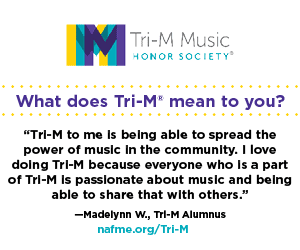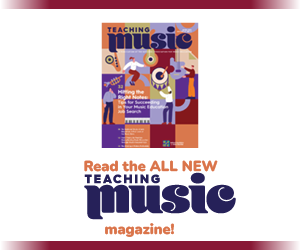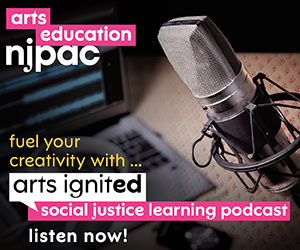/ News Posts / 6½ More Things Beginner Guitarists Should Know in Their 1st Year
The Other Half of the Baker’s Dozen:
6½ More Things Beginner Guitarists Should Know in Their 1st Year
By NAfME Member Christopher J. Perez
Director – Freedom High School Guitar Program, Orlando, FL
“The approach to what you do, results in what you get…”- Freddie Gruber (1927-2011)—Drummer and Master Teacher
In my earlier blog I shared half of what I call “The Baker’s Dozen.” Having presented this session at the 2017 NAfME National Conference last November in Dallas, TX, I was asked to share online the “Other Half of the Baker’s Dozen.” In the outline below, I will share more of what sources and strategies I use in my teaching.

The FHS Guitar Orchestra rehearsing in Elizabeth Hall at the 2017 Stetson University Guitar Day. -Photo courtesy of Christopher Perez
Classroom guitar teachers across the country utilize many different methods and styles of music. Regardless of what is taught, I have found that highly successful guitar classes and programs will cover similar fundamental performance techniques and employ a lot of notated music reading (solo and ensemble) to push and challenge students.
For my high school beginning guitar classes, students develop and master technical and musical skills that include scales, chord progressions (strumming and arpeggio patterns), chordal theory, note and rhythmic reading, barre chords, power chords, plus solo and ensemble repertoire. I firmly believe that there is not “ONE” stand-alone method or book that encompasses all that may be taught.
#8 – Arpeggios
A lot of guitar music is based on arpeggios. Regardless of genre or musical style, the ability to play arpeggios fingerstyle or with a pick is a necessary skill to develop. Knowing common voicing and unusual chord shapes will allow students to employ arpeggios in music.
- Regardless of genre, a lot of guitar music is based on arpeggios.
- Block, Broken, Chord Changes with and without Barres
- Prelude in C Major – Mateo Carcassi
- Snowflight by Andrew York from “8 Discernments” GSP Publications
#9 – Harmonics
Open-string harmonics are sometimes referred to as natural harmonics. To play open-string harmonics, you can place your finger lightly on the string in the places shown in the diagram below. Do not press the string down. It should not touch anything but your finger. By doing this, you will play the note shown in the diagram over the given area.
- Natural (frets 5 – 7 – 9 – 12) Most Common
- Artificial (Chromatic and above 12th fret)
#10 – Articulations
Developing the ability to play different articulations on guitar will allow more expressive elements in music performance to be displayed.
- Hammer-ons (ascending slurs) – After fingering the note with your pick or fingering hand, you tap the desired note above with one of your fingers.
- Pull-offs (descending slurs) – After fingering the note with your pick or fingering hand, with your other hand on the fret board, you pull-off or snap you finger off the string you are playing to create a slur to a lower note.
- Pizzicato/Staccato (muting) – This effect can be achieved by releasing your finger off the fret while still touching the string, thus muting (silencing) the note. Another way is to replant your picking finger back on the string to mute it.
- After fingering the note with your pick or fingering hand, with your other hand on the fret board, you pull-off or snap your finger off the string you are playing to create a slur to a lower note.
#11 – Sound Changes
There are different opportunities in performance to change the sound (instrument) of the guitar by employing different techniques.
- Rasgueado – The rasgueado is executed using the fingers of the strumming hand in rhythmically precise, and often rapid, strumming The important characteristic of this strumming style is the fingernail (outer) side of the finger tips (as opposed to their fleshy inner side) is also used, and in such case, in reverse of the way it is done when the fleshy side of the finger tips is used, namely downward (index, middle, ring and little finger) and upward (thumb).
- Tambour – To play tambour, stretch out the thumb and rotate the hand and wrist rapidly, causing the side of the thumb to strike the strings. Variation in tone can be achieved by striking different distances from the bridge and using different parts of the thumb (especially fleshy vs. bony parts). Variation in chord texture can be achieved by selecting different strings to strike. The sound would be similar to a snare drum played.
- Ponticello – Ponticello performance technique produces a more nasally and bright sound. This is achieved easily on an acoustic or classical guitar by fingering or picking very close 1” to 1½” off the saddle on the guitar.
- Tasto – Tasto is another technique that many guitarists use to change the tone of the guitar. This style is achieved by fingering or picking in the neck, usually where the neck and body of the guitar meet. The sound produced is one that is more quiet and more hollow sounding.
- Golpe – This technique is achieved by tapping your fingernail(s) on the body of the guitar.

The ability to perform in an ensemble requires a collaborative effort. -Photo courtesy of Christopher Perez
#12 – Power Chords
Many rock songs are played using power chords, using the root note and 5th note fingerings. They get their typical sound by plugging your guitar into an amplifier and using distortion effects.
- Nirvana – “Smells Like Teen Spirit” (F5-Bb5-G#5-C#5)
- Pat Benetar – “Hit Me With Your Best Shot”
- Chorus (E5-A5-C#5-B5)
- Verse (E5-D#5-C#5-A5-B5)
- Kelly Clarkson – “Since You’ve Been Gone”
- Verse (G5-A5-E5-F5)
- Chorus (B5-C5-G5=C5-B5-D5)
- Bridge (C5-E5)

Students need many opportunities to learn and perform different styles of music. -Photo courtesy of Christopher Perez
#13 – Blues
Having the ability to play the blues can allow students to experience a popular song style and to show off their improvisational skills. Knowledge and the practice of blues scales can lead to soloing. Great artists to listen to include Buddy Guy, Stevie Ray Vaughn, and Eric Clapton.
- Blues scales and changes
- Soloing
- More swing style using guitar ensemble music
- “57’ Chevy” by Leo Welch –
- Class Guitar Resources (CGR21)
- “Fix It!” by Romana Hartmetz
- Class Guitar Resources (CGR31)
- “57’ Chevy” by Leo Welch –
About the author:
NAfME Member Christopher Perez is the Director of Guitar Studies at Freedom High School in Orlando, Florida and a graduate of Western Illinois University. Selected as a Quarterfinalist for the 2017 GRAMMY Foundation Music Teacher of the Year Award, he remains very active as a teacher, presenter, adjudicator, clinician, composer/arranger and musician. Mr. Perez is a member of NAfME (National Association for Music Education) and serves on the Guitar Council as the Southern Division Representative, FMEA (Florida Music Education Association) serving on the FMEA Guitar/General Music Committee, GFA (Guitar Foundation of America), and Phi Mu Alpha Sinfonia.
Mr. Perez continually serves on several local and state music assessment writing teams. His music is published with Drop6 Media, Inc. and has several arrangements on the FBA State Music List. He is a percussionist with the Southern Winds Symphonic Band and with Walt Disney World’s “ENCORE! Cast Performing Arts”. Mr. Perez has presented sessions at NAfME, FMEA and OCPS Music Conferences and the FHS Guitar Ensembles continually perform on local, state, national and international stages. Under his direction, the FHS Guitar Ensembles performed several times as a demonstration music ensemble and in concert at FMEA All-State Music Conference in Tampa, Florida, at the Stetson University Guitar Day in DeLand, Florida and in concert at the 2013 & 2017 Long Island Guitar Festival in New York.
He may be contacted at Christopher.Perez@ocps.net. To learn more about the Freedom High School Guitar Program please visit www.fhsguitar.net.
Did this blog spur new ideas for your music program? Share them on Amplify! Interested in reprinting this article? Please review the reprint guidelines.
The National Association for Music Education (NAfME) provides a number of forums for the sharing of information and opinion, including blogs and postings on our website, articles and columns in our magazines and journals, and postings to our Amplify member portal. Unless specifically noted, the views expressed in these media do not necessarily represent the policy or views of the Association, its officers, or its employees.
Elizabeth Baker, Social Media Coordinator and Copywriter. March 26, 2018. © National Association for Music Education (stg-nafmemu-nafme.kinsta.cloud)
Published Date
March 26, 2018
Category
- Ensembles
- Standards
Copyright
March 26, 2018. © National Association for Music Education (NAfME.org)











